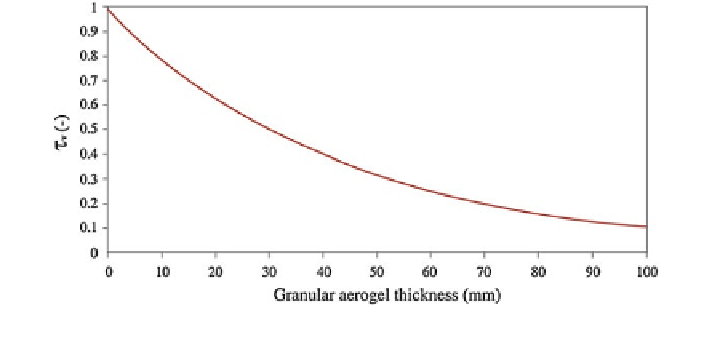Civil Engineering Reference
In-Depth Information
Fig. 5
Calculated light transmission through granular aerogel (adapted from Cabot 2009)
the reflected light, and a possible blurred deformation of optical images (Duer and
Svendsen
1998
).
The optical properties are influenced by the production process, i.e. by selecting
optimal synthesis parameters (Tajiri and Igarashi
1998
), and the transparency has
been improved in the last years.
Granular aerogel's light transmission (Cabot, see Fig.
5
) is about 80 % with
10 mm thickness, lower than the one of the monolithic samples with the same
thickness. It decreases by 20 % each time and its thickness increases by 10 mm: as
shown in the Fig.
5
, 10 mm of aerogel allows 80 % of light transmission.
The quality of the vision through the material decreases; nevertheless, it could be
preferred in some situations, because the light gets very deep in the room, and it can
significantly reduce glare problems in façade or skylight. Using aerogel in clear
windows can greatly affect the characteristics of the incoming light, which could
modify the colour appearance of surfaces and objects, contributing significantly to
the comfort and visual satisfaction of human beings. The quality of the transmitted
light can be usefully represented by the general colour rendering index R
a
:itis
based on the differences in colour between eight test colours lighted directly by a
reference illuminant and by the same illuminant after the transmission through the
glazing (EN 410
2011
); it is a normalized value in the 0-100 range, representing
100 no difference in colour. A value of 91 was found for 14-mm-thick aerogel panes
(Buratti and Moretti
2012
,
b
), which is a good value if compared to the clear glass
panes (R
a
values of about 98). When considering glazing systems with aerogel in
interspace, literature data (Buratti and Moretti
2012
,
b
) showed a very good quality
(R
a
[ 90): R
a
is lower than the one of windows with air in interspace (R
a
= 98 with
float glasses; R
a
= 94 with one low-e glass), but it is equal to 93 for float glasses
and granular aerogel (14 mm) and equal to 92 with monolithic aerogel. With low-e
glasses and granular aerogel, R
a
goes down to 90-91.
The transmittance of granular silica aerogels in the infrared spectral range is
low,
except in
the 3.5-5 lm
range
(see
Fig.
6
),
whereas the reflectance
is
negligible.

